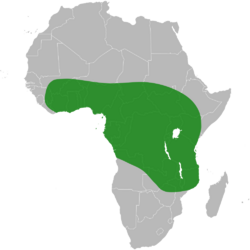Biology:Oryza barthii
| Oryza barthii | |
|---|---|
| Scientific classification | |
| Kingdom: | Plantae |
| Clade: | Tracheophytes |
| Clade: | Angiosperms |
| Clade: | Monocots |
| Clade: | Commelinids |
| Order: | Poales |
| Family: | Poaceae |
| Genus: | Oryza |
| Species: | O. barthii
|
| Binomial name | |
| Oryza barthii A.Chev.
| |

| |
| The range of Oryza barthii. | |
| Synonyms[2] | |
| |
Oryza barthii, also called Barth's rice,[3] wild rice,[4] or African wild rice,[5] is a grass in the rice genus Oryza. It is an annual, erect to semierect grass. It has leaves with a short ligule (<13 millimetres (33⁄64 in)), and panicles that are compact to open, rarely having secondary branching. The inflorescence structure are large spikelets, 7.7–12.3 millimetres (39⁄128–31⁄64 in) long and 2.3–3.5 millimetres (23⁄256–35⁄256 in) wide, with strong awns (up to 20 centimetres (8 in) long), usually red. The inflorescences have anthers 1.5–3 millimetres (15⁄256–15⁄128 in) long.
This wild rice grows in sub-Saharan Africa, and is found in mopane or savanna woodland, savanna or fadama. O. barthii grows in deep water, seasonally flooded land, stagnant water, and slowly flowing water or pools; it prefers clay or black cotton soils (vertisol), and is found in open habitats.[6] It is the progenitor of cultivated Oryza glaberrima, African rice.[7][8]
It has nodal roots hosting nitrogen fixing, photosynthetic strains of Bradyrhizobium.[9]
The sequenced genome of O. barthii was published in 2014.[10] This species is one of the AA species, the domesticated rices and their wild relatives.[8]
Distribution
O. barthii is primarily found in West Africa.[8]
References
- ↑ Phillips, J.; Yang, L.; Mani, S.; Vaughan, D. (2017). "Oryza barthii". IUCN Red List of Threatened Species 2017: e.T177184A1471268. doi:10.2305/IUCN.UK.2017-3.RLTS.T177184A1471268.en. https://www.iucnredlist.org/species/177184/1471268. Retrieved 10 December 2022.
- ↑ "The Plant List: A Working List of All Plant Species". http://www.theplantlist.org/tpl/record/kew-426604.
- ↑ "Oryza barthii". Natural Resources Conservation Service PLANTS Database. USDA. https://plants.usda.gov/core/profile?symbol=ORBA6. Retrieved 25 July 2015.
- ↑ {{citation | mode = cs1 | title = Oryza barthii | work = Germplasm Resources Information Network (GRIN) | url = | publisher = [[Organization:Agricultural Research ServAgricultural Research Service (ARS), United States Department of Agriculture (USDA) | access-date = 16 January 2018 }}
- ↑ "NCBI Taxonomy". https://www.ncbi.nlm.nih.gov/Taxonomy/Browser/wwwtax.cgi?id=65489.
- ↑ Rice Knowledge Bank, Wild Rice Taxonomic information, accessed 12.18.2007. [1]
- ↑ Linares 2002, African rice (Oryza glaberrima): History and future potential PNAS 99:16360-16365.
- ↑ 8.0 8.1 8.2 Chen, Erwang; Huang, Xuehui; Tian, Zhixi; Wing, Rod A.; Han, Bin (2019-04-29). "The Genomics of Oryza Species Provides Insights into Rice Domestication and Heterosis". Annual Review of Plant Biology (Annual Reviews) 70 (1): 639–665. doi:10.1146/annurev-arplant-050718-100320. ISSN 1543-5008.
- ↑ Chaintreuil, Clémence; Giraud, Eric; Prin, Yves; Lorquin, Jean; Bâ, Amadou; Gillis, Monique; de Lajudie, Philippe; Dreyfus, Bernard (December 2000). "Photosynthetic Bradyrhizobia Are Natural Endophytes of the African Wild Rice Oryza breviligulata". Applied and Environmental Microbiology 66 (12): 5437–5447. doi:10.1128/AEM.66.12.5437-5447.2000. PMID 11097925. PMC 92479. https://www.researchgate.net/publication/12229861. Retrieved 7 May 2021.
- ↑ Zhang, QJ.; Zhu, T.; Xia, EH.; Shi, C.; Liu, YL.; Zhang, Y.; Liu, Y.; Jiang, WK. et al. (Nov 2014). "Rapid diversification of five Oryza AA genomes associated with rice adaptation". Proc Natl Acad Sci U S A 111 (46): E4954–E4962. doi:10.1073/pnas.1418307111. PMID 25368197.
External links
Wikidata ☰ Q15296109 entry
 |


